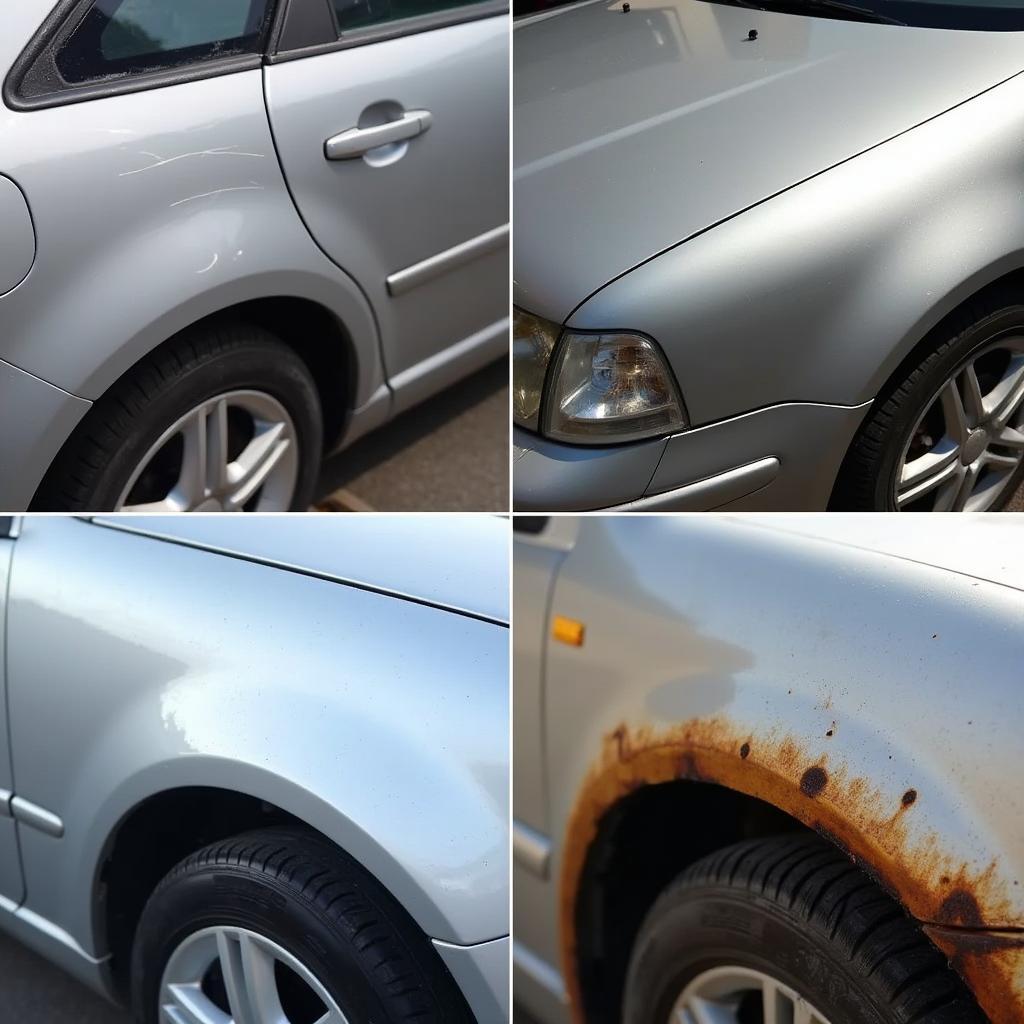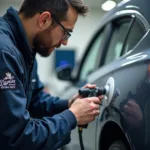Maintaining your car’s paint isn’t just about aesthetics; it’s crucial for protecting its value and ensuring longevity. Whether it’s a minor scratch, a dent requiring attention, or a complete color change, understanding the ins and outs of paint repair for cars can save you money and headaches down the road.
Why Car Paint Repair Matters
Your car’s paint does more than just make it look good. It acts as a shield against rust, UV damage, and environmental contaminants. Neglecting paint damage can lead to costly repairs later on.
Common Car Paint Issues
Let’s face it, our cars are subjected to a lot. From errant shopping carts to unexpected hailstorms, here are some common culprits behind paint damage:
- Scratches and Chips: These can occur from minor accidents, flying debris on the road, or even keying.
- Dents: Dings and dents can happen in parking lots, from hail, or even minor collisions.
- Fading and Oxidation: Exposure to the sun’s UV rays can cause paint to fade and lose its luster over time.
- Rust: Rust is a car owner’s worst nightmare, and it can quickly spread if chipped or damaged paint exposes the metal underneath.
DIY vs. Professional Paint Repair: Making the Right Choice
While minor scratches might seem like an easy DIY fix, knowing when to call in the professionals is key.
DIY Paint Repair:
- Pros: Cost-effective for minor scratches and chips.
- Cons: Requires careful color matching, technique, and patience. Can be time-consuming. Incorrect application can worsen the damage.
Professional Paint Repair:
- Pros: Ensures a high-quality, seamless finish. Experienced technicians have the expertise and tools for complex repairs.
- Cons: More expensive than DIY, but often worth it for lasting results.
Types of Professional Paint Repair for Cars
- Spot Repair: Ideal for minor scratches and chips, this involves repairing and repainting only the affected area.
- Panel Repair: When the damage is more extensive and covers a larger section, a panel repair might be necessary. This involves repairing or replacing an entire panel of the car’s body.
- Bumper Repair: Bumpers are prone to damage. Repair might involve filling, sanding, and repainting. In some cases, bumper replacement is more cost-effective.
- Complete Repaint: This option is typically chosen for extensive damage, a desire for a completely new color, or to restore a classic car.
Factors Affecting the Cost of Car Paint Repair
The cost of cost to repair paint on car can vary significantly depending on several factors:
- Extent of Damage: A small scratch is obviously cheaper to fix than a large dent requiring panel replacement.
- Type of Repair: Spot repairs are the most affordable, while complete repaints are the most expensive.
- Type of Paint: Certain car paints, like metallic or pearlescent finishes, are more complex to match and apply, impacting the cost.
- Location: Labor rates for auto body shops can vary based on location.
Mobile Paint Repair for Cars: Convenience at Your Doorstep
In today’s fast-paced world, convenience is key. Mobile paint repair for cars near me brings the repair shop to you. This service is gaining popularity for its flexibility and efficiency.
Maintaining Your Car’s Paint: Tips for Lasting Shine
- Regular Washing: Wash your car regularly to remove dirt, grime, and contaminants that can damage the paint.
- Waxing: A protective layer of wax can shield your car’s paint from UV rays, oxidation, and minor scratches.
- Avoid Parking Under Trees: Tree sap, bird droppings, and falling branches can wreak havoc on your car’s finish.
- Address Scratches Promptly: Even minor scratches can worsen over time. Addressing them quickly can prevent rust and further damage.
Paint and Body Repair for Muscle Cars: Restoring Automotive History
Muscle cars hold a special place in automotive history. Paint and body repair muscle cars requires a unique skillset and a deep understanding of classic car restoration techniques.
Minor Paint Repair on Cars: Quick Fixes for Small Imperfections
Not all paint damage requires a trip to the auto body shop. Minor paint repair on cars can often be addressed with DIY solutions:
- Scratch Pens: These pens contain touch-up paint that can help conceal minor scratches.
- Scratch Removal Kits: These kits usually contain a rubbing compound and polish to buff out minor scratches.
Scratch Pen for Cars Paint Repair: A Handy Tool for Minor Blemishes
A scratch pen for cars paint repair is a quick and easy way to address minor scratches and chips. When choosing a scratch pen, ensure you get the correct color match for your car’s paint.
Conclusion
Maintaining your car’s paint is an investment in its appearance, value, and longevity. Whether you opt for DIY solutions for minor imperfections or seek professional help for more serious damage, remember that proactive care is key. By understanding the nuances of paint repair for cars, you can keep your vehicle looking its best for years to come.
FAQs about Car Paint Repair
Q: How long does car paint repair take?
A: The timeframe for car paint repair varies greatly depending on the extent of the damage and the type of repair needed. A minor scratch repair could take a few hours, while a complete repaint could take several days.
Q: Can I wash my car after paint repair?
A: It’s best to wait a few days to a week before washing your car after paint repair. This allows the paint to fully cure and harden.
Q: Does car insurance cover paint repair?
A: Coverage for paint repair depends on your specific insurance policy and the circumstances of the damage.
Need help with a paint issue or looking for expert advice? Contact us via WhatsApp: +1(641)206-8880, or Email: [email protected]. Our team of car care specialists is available 24/7 to assist you.



